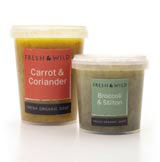Retail facelift au naturel
Natural product brands are updating their style – rethinking store design, displays and packaging in response to supermarket competition, says Scott Billings

The popularity of all things all-natural is forcing health retailers to up the ante in the design of their stores, brands and products. Gone are the days when health food stores were the reserve of hessian-clad health nuts: the shopping experience must now be contemporary, exciting and authentic.
As the market grows and supermarkets make in-roads into the health sector, specialist apothecaries, herbalists and health food retailers are no longer quite so exclusive. It seems that simply offering natural products is no longer a customer clincher.
To adapt to the changing market, herbal retailer Culpeper has embarked on a broad brand ‘revitalisation’ programme that will refresh its identity, packaging and product range, alongside a new concept store format to appear in the Covent Garden and Bath outlets ahead of Christmas (DW 9 September).
Meanwhile, natural food and toiletries group Crabtree & Evelyn is reorienting its brand and shops toward a more ‘contemporary, lifestyle’ experience, led by creative director Robin Anderson and Harpenden interior design group Tait Design (DW 9 September).
The investment in Culpeper follows its acquisition by private shareholders earlier this year. ‘The company had fallen on hard times and we felt that it could be revitalised alongside a growing interest in natural and herbal products,’ says chairman and co-investor John Ayton.
Ringing the changes at Culpeper is creative director and investor Peter Windett, who has previously worked for Crabtree & Evelyn and luxury fragrance brand Floris. ‘When we bought the company we inherited an authentic English brand name, but also a tired brand. By the 1990s there had been no investment in retail or products and the packaging was poor when compared to other high street brands,’ he explains. The Culpeper retail designs are a collaboration with architect William Russell, designer of Alexander McQueen’s stores. ‘We have gone out on a limb with Russell, who comes from a domestic architecture and fashion background, but we want the new stores to differ totally from the previous ones, with a certain amount of interaction taking place in the shop,’ explains Windett.
Crabtree & Evelyn is opening a boutique-style concept format next week, in its new shop in the Covent Garden Market Piazza in London. As with Culpeper, the company’s presentation has not seen any major changes since its inception 35 years ago, says the retailer’s creative director Robin Anderson.
‘The Crabtree & Evelyn stores have been modified and adapted over the years, but no one has taken a serious look at the concept for a long time,’ he says. ‘We are now getting a much younger customer through the door and are moving towards a more contemporary look for the shops, using lifestyle elements.’ The shops will be lighter than previously, with a new approach to merchandising. ‘We are moving away from fixed fittings and introducing more furniture and wood to the shops,’ Anderson explains.
Tait Design worked alongside Anderson’s seven-strong design team to help create the look of the Crabtree & Evelyn stores. Director Linda Tait sees a trend in the natural products sector to more modern store and product design.
‘I don’t necessarily mean slick,’ she explains. ‘Aveda is very contemporary, but still raw, earthy and honest. The Body Shop’s recent refit is more contemporary, but uses hessian for texture [DW 1 July]. Space.NK is perhaps the only one to go slick rather than bring in natural textures.’
French natural cosmetics brand L’Occitane sits at the other end of the scale, says Tait – it eschews current trends in favour of a traditional, French provincial look.
Culpeper’s Windett also cites Aveda as a successful natural products brand. ‘It has a much younger, urban customer [than Culpeper]. The mature customer with disposable income is the core market for us,’ he adds.
The Forster Company has created branding and packaging designs for Fresh & Wild and was recently appointed by kids’ food manufacturer Organix to review its branding (DW 2 September). Creative director Brian Wall believes that the trends in the sector are towards honesty of presentation.
For Fresh & Wild Wall photographed the food suppliers at work – fisherman catching the fish, for example – and displayed the images in-store. Neal’s Yard’s recent store revamp by The Nest also featured photographs of the company’s herbal gardens (DW 4 December 2003).
‘There has to be honesty about things,’ claims Wall. ‘Design is becoming more sophisticated than it was [in the sector] in the 1970s, but it’s essentially about telling the story of the product’s origins as honestly as possible.’
A literal example of this approach is the trend towards clear packaging, says Wall. ‘See-through packaging is very popular. People want to see what’s inside. Also, just throwing in terms like “fresh from” is meaningless now. It’s hard for designers to convey the necessary authenticity, but it’s also a great challenge.’
-
Post a comment



